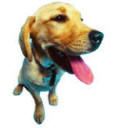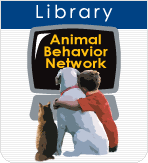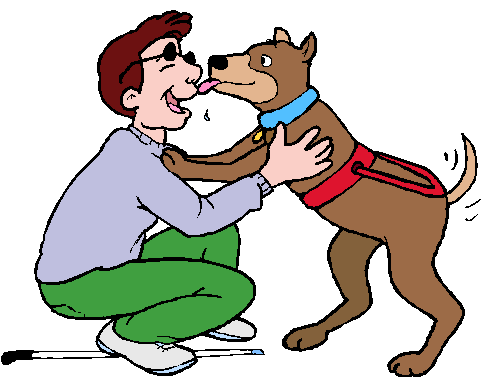|
Need Help?
|
|
Call
1-800-372-3706
to
speak to a Veterinary Behavior Technician |
|
Paws To Speak!
Member
Main Menu
|

Basic Training
Principles

Pet Professional Tip
Establish a consistent vocabulary and routine for
boarding and hospitalized dogs. Ask dog's to sit
before going in and out of doors. Practice what you
preach by teaching good behavior and by NOT
rewarding unwanted behaviors such as pulling on
leash. Make it in the dog's best interest to respond
to your instructions in a new location by offering
treats and praise.
|
 |
|
Help is at your
fingertips by library, email and
phone. |

Click on
Library Icon
to learn more
|
Introduction
The best time to begin teaching house rules is the day your bring a
new puppy or dog home. Before bringing a new dog home, it is helpful
to think about what rules you want for the adult dog long term. If
you want a well-mannered dog, then you must establish, teach and
reinforce a clear set of rules. Learn more...Dog
Basic Training Principles
Recommended household rules
1. No dogs allowed
on the furniture. If you want your dog to spend time on the
couch or bed with you, then teach the dog a "cue" such as "couch"
and "bed" and then do NOT allow the dog on the furniture without
getting the cue first. Teach the dog it is ONLY okay to be on the
furniture with permission. This is not an easy lesson for dogs to
learn. You must also teach the word, "off" and be consistent
in telling the dog to get "off" if the dog gets up without
permission. Learn how to use
Instructive Praise
2. No dog teeth allowed on human skin.
If is NOT okay for dog teeth to touch human skin. Teach dogs
to first
do gentle mouthing, second not to
mouth without permission, and finally
not to mouth at all.
Read more...click
here.
|
Ignore behaviors you don't
want and praise behaviors
you do want. |
3. No dog feet
on people. Do NOT allow the dog's front legs up on people for
any reason. It is easier for people to pet or hug a dog that is up on two feet.
Allowing the dog to get attention in this way leads to trouble.
Unless your dog is small and you WANT this behavior for a lifetime,
get down on the dogs level and ONLY give attention when the dog has
all four feet on the ground. Instead, teach the dog to "sit" for
greetings and praise. Do a quarter turn and do not give the dog eye
contact if the dog jumps on you.
people to pet or hug a dog that is up on two feet.
Allowing the dog to get attention in this way leads to trouble.
Unless your dog is small and you WANT this behavior for a lifetime,
get down on the dogs level and ONLY give attention when the dog has
all four feet on the ground. Instead, teach the dog to "sit" for
greetings and praise. Do a quarter turn and do not give the dog eye
contact if the dog jumps on you.
4. No
barking away from home. Do not allow your dog to
bark at people, animals or objects when you are off
your property. You may want some barking at people
when your dog is being a "watchdog" on your
property. Teach your dog the "quiet"
instruction at home so that you
can use it for times outside of the home when you
want the dog to stop barking. At home, do not
allow your dog to join in with neighborhood dog
barking as this habit can become a nuisance.
5. No canines
blocking human paths. Do not let sleeping dogs lie if that dog
is in your path. Teach your dog what the word, "move" means and then
use it to move the dog out of your way. You don't need a dog
underfoot when you have an arm full of groceries. Dogs that block
pathways often perceive they are controlling a power area which may
lead to a misperception that the people in the house are there to
serve the dog instead of the opposite.
|
Introduce the kennel as
the dog's most comfortable,
safe den where good things -
such as toys, treats and
praise - always happen.
|
6. No food
bowl or toy guarding. Do not allow dogs to think
that food and toys belong to them. Instead, teach
the dog that you own and control ALL the valued
resources in the home. Show the dog how generous you
can be if the dog shows you deference to your
leadership. In other words, always ask the do to
"earn" his supper or a toy by asking the dog to do
something for you, FIRST, such as sit, lie down,
roll-over...you get the idea! Do not allow the
dog to guard food or possessions from any people,
under ANY circumstances. As with all rules, begin
this lesson on day one!
7. No
household destruction. Do not allow the dog to destroy dog toys
not designed for destruction (e.g., balls, squeaky toys, plush toys,
or anything made of fabric.) The dog may not know how much you
paid for that item but they do need to know the item is NOT theirs
to destroy. Supervise all play. If the dog begins to show
destructive chewing, take the toy away.
8. Always come
when called. Teach your dog to come when called.
Do not accidentally punish the dog for coming to you
when called by then putting the dog outside,
punishing the dog for not coming quickly, or giving
the dog a bath. NEVER follow the word, "come" with
an action that is unpleasant for the dog.
9. Cheerfully
go into your kennel. Teach the dog a "kennel up" instruction to cue
the dog to enter the kennel upon request. The goal is for the dog to
LOVE being in the kennel and to respond to this cue with delight.
Teach your dog "contented confinement" from day one.
Read
more...click
here.
|